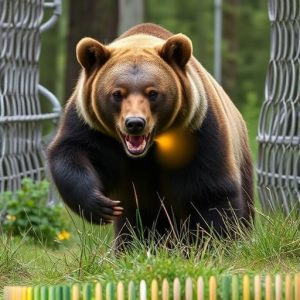Unleashing Power: Bear Spray Ingredients, Wind Impact, & Safety Guide
Bear spray, containing capsaicin oleoresin from chili peppers, is crucial for self-defense against a…….
Bear spray, containing capsaicin oleoresin from chili peppers, is crucial for self-defense against aggressive bears. Effective usage requires understanding wind direction; aim away from yourself towards bears to ensure the spray reaches them directly. Key safety tips include proper training, keeping bear spray accessible, and using a defensive rather than offensive posture for optimal effectiveness.
“Unveiling the secrets of bear spray, a vital tool in navigating wild territories, this article offers an insightful guide. We explore the powerful active ingredient, capsaicin oleoresin, and its role in deterring bears effectively. Understanding wind direction is key to maximizing its effectiveness.
Learn essential safety tips for optimal performance and personal protection when using bear spray. Additionally, we break down how to choose the right spray based on active ingredients and concentrations, ensuring you’re prepared for any outdoor adventure.”
- Understanding Bear Spray: What Is It and How Does It Work?
- The Key Ingredient: Capsaicin Oleoresin – A Natural Pepper Compound
- Wind Direction: A Critical Factor in Effective Bear Spray Usage
- Safety Tips for Optimal Bear Spray Performance and Personal Protection
- Choosing the Right Bear Spray: Active Ingredients and Concentrations Explained
Understanding Bear Spray: What Is It and How Does It Work?
Bear spray, also known as bear repellent, is a specialized product designed to deter and protect against aggressive bears when venturing into their habitats. Understanding its active ingredients is key to comprehending its effectiveness. The primary active ingredient in bear spray is capsaicin oleoresin, derived from chili peppers. This compound creates a burning sensation in the eyes, nose, and throat of bears, temporarily disorienting them and allowing for a safe escape.
When using bear spray, it’s crucial to be aware of the wind direction. Spraying towards your face is not recommended as it can cause severe irritation. Instead, point the nozzle away from you, towards the bear, and use the spray in a sweeping motion. Safety tips include ensuring proper training on how to use the spray effectively, keeping it readily accessible, and being aware that it’s most effective when used defensively rather than offensively.
The Key Ingredient: Capsaicin Oleoresin – A Natural Pepper Compound
Capsaicin oleoresin is the star ingredient in bear spray, a vital tool for safety tips when navigating potential bear encounters in the wild. This powerful compound is derived naturally from peppers, specifically Capsicum species, and is known for its ability to cause a burning sensation in humans. However, it’s this very property that makes capsaicin oleoresin an effective deterrent against bears. When sprayed, the capsaicin irritates the bear’s eyes, nose, and throat, temporarily disorienting them and encouraging a quick retreat.
Understanding the wind direction is crucial when using bear spray. It’s recommended to carry it in a manner that allows you to aim away from yourself and towards potential bear threats. When sprayed correctly, capsaicin oleoresin forms a cloud that can reach distances up to 20 feet, providing a safety zone. Regularly testing the spray and staying informed about its effectiveness against different bear species is essential for optimal protection in various environments.
Wind Direction: A Critical Factor in Effective Bear Spray Usage
The effectiveness of bear spray is greatly influenced by the wind direction during its usage. Understanding this factor is crucial for ensuring safety when encountering bears in wild environments. When applying bear spray, it’s best to face into the wind or have it blowing away from you. This strategic positioning allows the capsaicin oleoresin, the active ingredient responsible for deterring bears, to travel directly towards the animal.
By aiming bear spray against the wind, you maximize its reach and impact, creating a protective barrier between you and potential danger. Conversely, spraying into the wind can result in the chemical blowing back onto you, rendering it less effective. Therefore, incorporating awareness of wind direction into your safety tips when carrying bear spray is an essential component for staying secure during encounters with these powerful wildlife species.
Safety Tips for Optimal Bear Spray Performance and Personal Protection
When using bear spray, understanding the wind direction is crucial for optimal performance and personal safety. Always scan the area for potential breeze or air currents before deploying the spray. Aiming into the wind ensures that the capsaicin oleoresin, the active ingredient known for its effectiveness against bears, reaches the target effectively. Conversely, spraying against the wind may result in the chemical blowing back towards you, negating its protective effects.
To maximize protection, keep a safe distance from potential bear encounters. Maintain at least 100 feet (30 meters) between you and any observed bears. This buffer zone allows for proper deployment of bear spray while minimizing risks associated with bear behavior. Additionally, carry the spray in an easily accessible location, such as on a belt or in a hands-free holster, to ensure prompt use should a bear approach unexpectedly.
Choosing the Right Bear Spray: Active Ingredients and Concentrations Explained
When choosing a bear spray, understanding the active ingredients and their concentrations is key to ensuring maximum safety in bear country. The primary active ingredient in most bear sprays is capsaicin oleoresin, derived from chili peppers. This ingredient irritates a bear’s eyes, nose, and respiratory system, causing it to retreat.
Concentration is measured in parts per million (ppm). Higher ppm typically offer longer range and stronger effects. However, it’s not just about strength; consider the spray’s effectiveness against different wind directions. Bear sprays with finer mists are better for headwinds, as they stay on target. Conversely, thicker sprays might be more suitable for tailwinds due to reduced spread. Always follow safety tips, like testing the spray beforehand and ensuring you can reach the bear from a safe distance.
Bear spray is a valuable tool for personal protection in bear country, but its effectiveness heavily depends on proper usage and understanding of key factors like wind direction. By selecting the right concentration and actively considering environmental conditions, you can maximize the safety provided by your bear spray. Always follow safety tips and stay informed to ensure a safe outdoor experience.


